Grace Elliot's Blog: 'Familiar Felines.' , page 15
September 18, 2013
My Mary Rose Experience
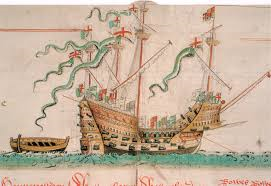 Watched by Henry VIII, the Mary Rose sank in the Solent,
Watched by Henry VIII, the Mary Rose sank in the Solent,19 July, 1545During the summer I visited the Historic Dockyard, Portsmouth to see the Mary Rose. I last saw her in 1987 when I went with my then boyfriend, and now-husband of 24 years. All I remember from back then was a large damp (I was courting and worried about frizzy hair!) shed, and I could just make out a huge lump of wood behind a veil of mist.
This summer's visit was very different! The timbers of the Mary Rose are drying out and a clever display recreates what conditions were like within each corresponding deck of the ship. There are also traditional displays of artefacts, and in this week's blog post, I share some of my favourite items.
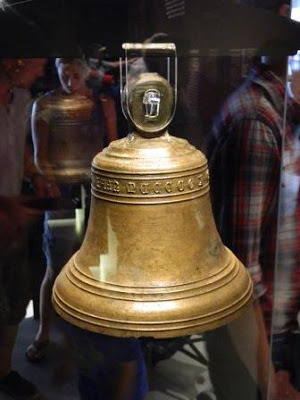 The ship's bell.
The ship's bell.Author's own photo.It's astounding to think of the history associated with this bell and the number of Tudor sailors who would have seen or heard it. The bell was made from brass, in Antwerp at a foundry that specialised in bells. It was one of the few artefacts present on the Mary Rose throughout her 33 year career from launch to sinking.
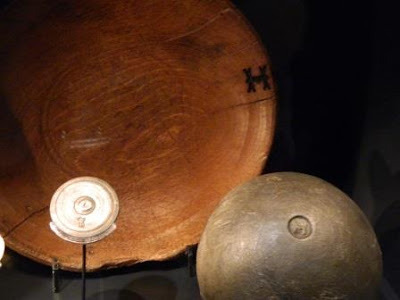 Wooden plates and bowls
Wooden plates and bowls Author's own photo.One of the reasons I'm interested in history is the fascination of how people lived. There is no better illustration of this than the beautiful wooden plates and bowls found on board the Mary Rose. The crew would have eaten from them, and individuals marked their property by carving their initials - as seen in the picture above.
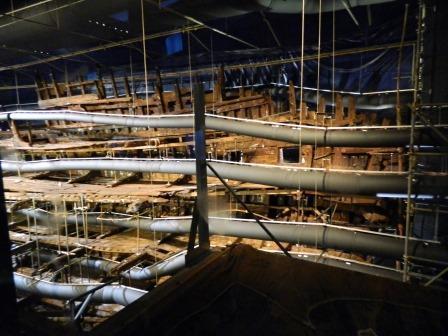 The Mary Rose - August 2013
The Mary Rose - August 2013Author's own photoHaving walked through the first exhibition hall, the visitor enters a long viewing gallery overlooking the actual Mary Rose. The pipes are no longer spraying the wreck with polyethylence glycol, although it can still be difficult to make out details. However, on the opposite side of the walkway, the museum have recreated what the deck would have looked like - including placing actual artefacts in the scene.
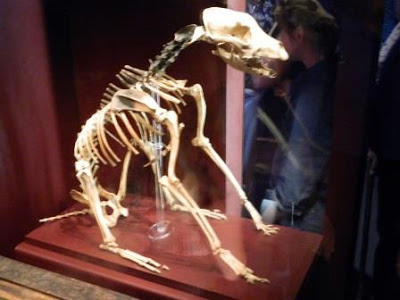 A dog - found outside the carpenter's door.
A dog - found outside the carpenter's door.Author's own photo.Any ship would have been rife with rats and vermin, and perhaps that is why a dog was on board. The skeleton of a whippet type animal, aged around 18 - 24 months was found outside the carpenter's door. (On the way out of the museum, passing through the gift shop, I was amused to see a plush toy replica of the dog! )
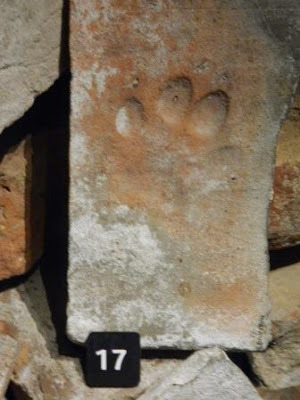 Paw print on a tile found in the galley.
Paw print on a tile found in the galley.Author's own photo.Sticking with the dog theme, another item that caught my imagination was this clay tile. It was found in the galley area, one of hundreds of tiles packed around the large cooking cauldron to protect the ship's timbers from the fire beneath. How extraordinary is it, to think nearly half a millennia ago a dog ran across wet clay, and that tile found it's way onto the Mary Rose and then lay under the sea for hundreds of years...
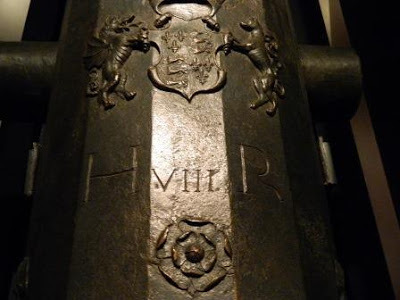 One of the many cannons found on board
One of the many cannons found on boardAuthor's own photo.
Of course the Mary Rose was a warship and so no post would be complete without a mention of her armaments. What struck me about the many cannons recovered, was how each had beautiful casting and engravings - each obviously created with reverence and pride. Far from being mere functional, they are art works in their own right.
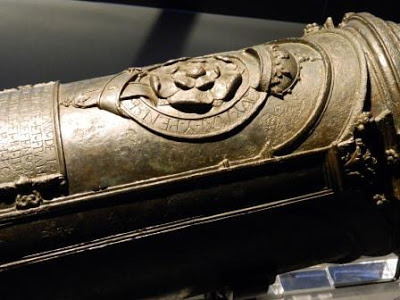 Another of the Mary Rose's cannons.
Another of the Mary Rose's cannons.Author's own photoAnd finally... this made me chuckle on the way out through the ubiquitous gift shop. How about remembering your visit to the Mary Rose by purchasing a plush toy rat?
 Author's own photoHave you visited the Mary Rose? What did you make of your experience?
Author's own photoHave you visited the Mary Rose? What did you make of your experience?
Published on September 18, 2013 01:10
September 13, 2013
Fall into Romance - blog hop
Who are your Auto-buy Authors?
Today I’m delighted to take part in The Romance Reviews blog hop. As part of the hop I’m supposed to post about my favourite romance book – but after writing a shortlist the length of an A4 paper I threw up my hands in frustration. My problem lies in loving most of the books written by my favourite authors – How to choose between them?
[GIVEAWAY details at the end of this post]

I might, just might, be able to choose a favourite series – but even that is a tough call. It would be between Tessa Dare’s, ‘Spindle Cove’, and Elizabeth Hoyt’s ‘Maiden Lane’ series. Both authors provide in spadefuls what I look for in a first class read: the escapism of the past, heroes with hidden secrets and wilful, but honourable heroines battling their attraction to an unsuitable lover.

You’ve probably guessed by now that I’m a fan of historical romance. Other authors who I can usually rely on to feed my addiction are Lisa Kleypas (especially her yummy ‘Bow Street’ books), Mary Balogh and Katharine Ashe. Most of these authors are on my ‘auto-buy’ list, but I’m always on the look out for new recommendations – this leads me to ask, who are your auto-buy authors?
Do share them with us (they don’t have to be historical romance) by leaving a comment.

Leave a comment below for a chance to win. I’m offering three lucky people their choice of an eBook copy of Eulogy's Secret, Hope's Betrayal or Verity's Lie from The Huntley Trilogy [see side bar for details].
Please leave a contact email address and which book you would like to win.
The hop runs until September 21st - so plenty of time to comment here and visit the other stops!
Good luck.
G x Click to visit the next stop!
Click to visit the next stop!
Today I’m delighted to take part in The Romance Reviews blog hop. As part of the hop I’m supposed to post about my favourite romance book – but after writing a shortlist the length of an A4 paper I threw up my hands in frustration. My problem lies in loving most of the books written by my favourite authors – How to choose between them?
[GIVEAWAY details at the end of this post]

I might, just might, be able to choose a favourite series – but even that is a tough call. It would be between Tessa Dare’s, ‘Spindle Cove’, and Elizabeth Hoyt’s ‘Maiden Lane’ series. Both authors provide in spadefuls what I look for in a first class read: the escapism of the past, heroes with hidden secrets and wilful, but honourable heroines battling their attraction to an unsuitable lover.

You’ve probably guessed by now that I’m a fan of historical romance. Other authors who I can usually rely on to feed my addiction are Lisa Kleypas (especially her yummy ‘Bow Street’ books), Mary Balogh and Katharine Ashe. Most of these authors are on my ‘auto-buy’ list, but I’m always on the look out for new recommendations – this leads me to ask, who are your auto-buy authors?
Do share them with us (they don’t have to be historical romance) by leaving a comment.

Leave a comment below for a chance to win. I’m offering three lucky people their choice of an eBook copy of Eulogy's Secret, Hope's Betrayal or Verity's Lie from The Huntley Trilogy [see side bar for details].
Please leave a contact email address and which book you would like to win.
The hop runs until September 21st - so plenty of time to comment here and visit the other stops!
Good luck.
G x
 Click to visit the next stop!
Click to visit the next stop!
Published on September 13, 2013 03:00
September 11, 2013
Invading the Isle of Wight
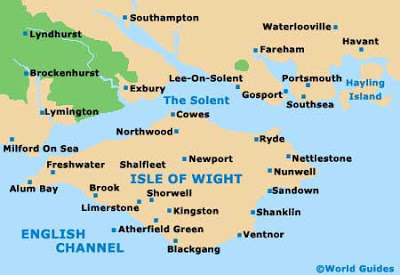 “The very notion of anyone invading the Isle of Wight seems absurd and even, much like the island itself, a bit quaint… With its benign climate, agricultural fertility, excellent ice-cream and numerous B&B establishments, it would suit a committed group of idealists bent on establishing a utopian societal model… But the best reason for invading the Isle of Wight is that they definitely won’t be expecting it.”James May
“The very notion of anyone invading the Isle of Wight seems absurd and even, much like the island itself, a bit quaint… With its benign climate, agricultural fertility, excellent ice-cream and numerous B&B establishments, it would suit a committed group of idealists bent on establishing a utopian societal model… But the best reason for invading the Isle of Wight is that they definitely won’t be expecting it.”James MayHow to Land an A330 Airbus: and Other Vital Skills for the Modern Man
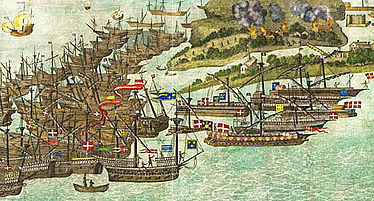 The French fleet attacks Bembridge, Isle of WightToday’s blog post is on the theme of ‘invading the Isle of Wight’. Now this is not as random as it seems because whilst on holiday there this summer, I came across several references to previous invasion attempts. Indeed, the Roman Villa at Brading is testament to the islands vulnerability in 300AD. But unlike James May’s assertion a couple of years ago that, “they definitely won’t be expecting it”, in previous centuries significant efforts were made to protect the island.
The French fleet attacks Bembridge, Isle of WightToday’s blog post is on the theme of ‘invading the Isle of Wight’. Now this is not as random as it seems because whilst on holiday there this summer, I came across several references to previous invasion attempts. Indeed, the Roman Villa at Brading is testament to the islands vulnerability in 300AD. But unlike James May’s assertion a couple of years ago that, “they definitely won’t be expecting it”, in previous centuries significant efforts were made to protect the island. 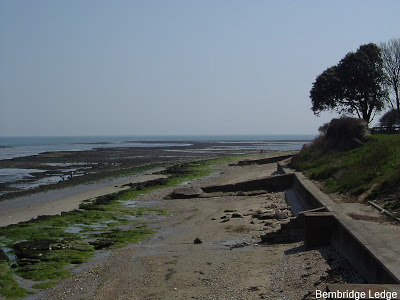 Modern day Bembridge (photo author's own)This post is not an exhaustive account of the history of invasion, but more a reflection on three interesting events in the history of the island. Situated off the South Coast of England, in the Solent, the Isle of Wight gave the would-be-invader of the mainland a huge strategic advantage. With sheltered harbours, plentiful fresh water and good agricultural land, it was the perfect place for an invading army to regroup and refuel before launching a major assault on England.
Modern day Bembridge (photo author's own)This post is not an exhaustive account of the history of invasion, but more a reflection on three interesting events in the history of the island. Situated off the South Coast of England, in the Solent, the Isle of Wight gave the would-be-invader of the mainland a huge strategic advantage. With sheltered harbours, plentiful fresh water and good agricultural land, it was the perfect place for an invading army to regroup and refuel before launching a major assault on England. 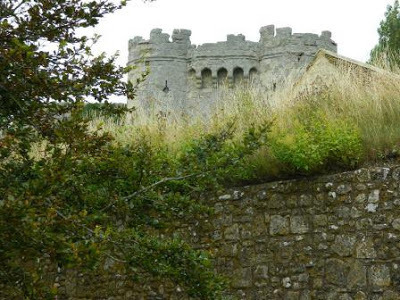 Carisbrooke Castle from the road (author's own photo) Repelling the FrenchIn medieval times, the French were keen to gain control of the Isle of Wight (IOW). During the Hundred Years War (1337 – 1453 – you do the maths!) occupying the IOW would have given them control of the waters around the south coast of England.
Carisbrooke Castle from the road (author's own photo) Repelling the FrenchIn medieval times, the French were keen to gain control of the Isle of Wight (IOW). During the Hundred Years War (1337 – 1453 – you do the maths!) occupying the IOW would have given them control of the waters around the south coast of England. Between 1336 and 1370 they raided the island five times. But in 1377 they became bolder still. Key to defense of the IOW was Carisbrooke Castle. The French invaded in strength to the north, laying waste to Yarmouth and Francheville, before laying siege to the castle. The attacking force used trebuchets, ladders and crossbows but the story goes that they were defeated by a lone English bowman, Peter de Heynoe.
 View from the ramparts of Carisbrooke Castle (author's own photo)De Heynoe watched from the ramparts and picked out the French commander. With a single arrow he slew their leader, leaving the French force in disarray and they subsequently abandoned their attack. Later, the castle was further fortified and the French continued to raid until the early 15th century.
View from the ramparts of Carisbrooke Castle (author's own photo)De Heynoe watched from the ramparts and picked out the French commander. With a single arrow he slew their leader, leaving the French force in disarray and they subsequently abandoned their attack. Later, the castle was further fortified and the French continued to raid until the early 15th century. The Threat in Tudor TimesDuring the 16thcentury at various times both the French and the Spanish posed threats at various times. King Henry VIII decided it was time to invest in the Island defenses and built coast forts at Cowes, Sandown, St Helens and Yarmouth – sometimes using stone from dissolved monasteries. Carisbrooke Castle became used as a munitions store.
 Priory Bay - IOW
Priory Bay - IOWOne of the many beautiful coves to be found on the island -
as good a reason as any to invade!
(Author's own photo)
It was during one of these skirmishes between the English and the French, that the Mary Rose was lost in 1545. From his viewpoint at Southsea Castle, looking across the Solent with the IOW clearly visible, King Henry VIII watched his flagship lead the attack on galleys of the French invasion fleet, only to see the Mary Rose founder and sink.
During Elizabeth I’s reign, an example of the key position played by the IOW was the dramatic sight, on the morning of 26 July 1588, of the Spanish Armada sailing in waters off the islands coast.
“This morning began a great fight between both fleets…[which] were out of sight by three in the afternoon.”
Sir George Carey. (Captain of Carisbrooke Castle under Elizabeth I)
Trivia alert! George Carey was the grandson of Mary Boleyn (sister of Anne Boleyn), and Elizabeth I’s cousin
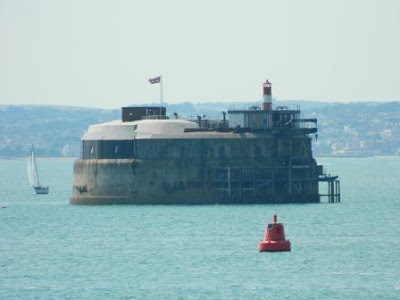 A Palmerston fort viewed from Southsea Castle, on the mainland,
A Palmerston fort viewed from Southsea Castle, on the mainland, looking across the Solent with the Isle of Wight clearly visible.
(Author's own photo) The Palmerston Forts or Follies?From the north coast of the Isle of Wight a number of marine forts are clearly visible, built in the waters of the Solent, with the purpose of protecting the Solent. These forts were built in Victorian times on the recommendation of the 1860 Royal Commission on the Defence of the United Kingdom. There was a parliamentary debate about whether the cost of their construction could be justified and the cause was championed by the then Prime Minister, Lord Palmerston. However, it seemed he jumped the wrong way because by the time they were completed the French threat of invasion had passed, and the weapons technology with which they were equipped was outdated – hence the nickname Palmerston’s Follies.
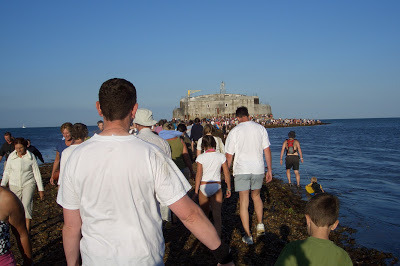 My husband in the foreground on a 'walk to the fort' -
My husband in the foreground on a 'walk to the fort' - traversing a gravel path that becomes visible only at extreme low tide.
Palmerston fort in the background.I find these forts fascinating. They are clearly visible in the Solent and have a definite ‘presence’. At certain times of the year the tide is low enough to ‘walk to the fort’ – along the seabed – I’ve done this a couple of times and it has a biblical feel about it, with the sea lapping at your ankles on either side.
Published on September 11, 2013 02:35
September 4, 2013
The Great Fire of London - Eye-witness Accounts
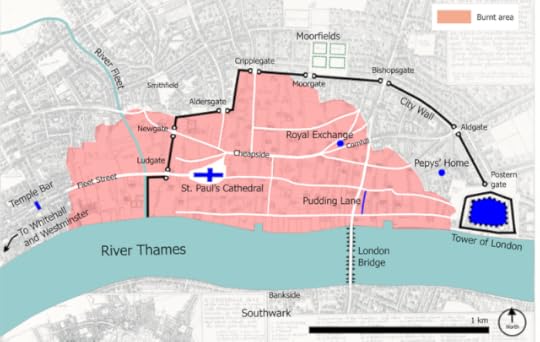 The pink areas indicate those parts of London destroyed in the Great FireThis week it’s my brother’s birthday, a date he shares with the anniversary of another significant historical event – the Great Fire of London in 1666. It seemed appropriate to mark his birthday on my blog with eye-witness accounts of the Great Fire, almost 350 years ago (OK, it was 347 years – but that doesn’t sound as momentous.)
The pink areas indicate those parts of London destroyed in the Great FireThis week it’s my brother’s birthday, a date he shares with the anniversary of another significant historical event – the Great Fire of London in 1666. It seemed appropriate to mark his birthday on my blog with eye-witness accounts of the Great Fire, almost 350 years ago (OK, it was 347 years – but that doesn’t sound as momentous.)
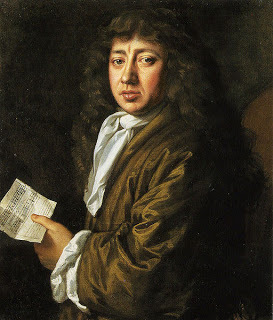 Samuel Pepys- diarist In the early hours of Sunday 2 September 1666, Mr and Mrs Samuel Pepys were woken by their maid, Jane, to tell them of a fire within the city. Pepys was concerned enough to rise in his nightgown for a look but recorded:
Samuel Pepys- diarist In the early hours of Sunday 2 September 1666, Mr and Mrs Samuel Pepys were woken by their maid, Jane, to tell them of a fire within the city. Pepys was concerned enough to rise in his nightgown for a look but recorded:“Thought it far enough off, and so went to bed again and to sleep.”
At 7am the news was not good:“Jane comes and tells me that she hears that above 300 houses have been burned down to-night by the fire we saw, and that it is now burning down all Fish-street by London Bridge.”
To investigate Pepys took to a boat on the Thames, to get the view from the river. He found a four acre area of light industry and warehouses ablaze. On a large scale people evacuated their houses and public order began to break down as they looked for someone to blame.
It seems London’s population turned against foreigners, and in particular the French, as the likely culprits for starting the fire. A schoolboy recorded a terrible incident where a blacksmith attacked ‘an innocent Frenchman’ with an iron bar. Another report was of a Frenchman ‘almost dismembered’ by a mob who thought he had firebombs (they were actually tennis balls.)
The reason the fire was so severe was the medieval city of London consisted of closely packed wooden buildings with gables practically touching. That and a high wind that fanned the flames and that the city was dry for want of rain, added together to make an inferno.
“The wind got up mighty high…driving the fire into the city…and everything after so long a drought was proving combustible, even the very stones of the churches.”
That Sunday evening (day 1 of the fire) Pepys and his wife sat in a wharf alehouse and watched the flames.“An arch of above a mile long: it made me weep to see it.”
 The Duke of York,
The Duke of York, the future King James IIBy Monday morning (day 2), that same alehouse had been destroyed. The brother of King Charles II, took charge. James, the Duke of York, recognised drastic action was needed and ordered whole streets to be demolished. But the fire continued to spread and the Royal Exchange, one of the landmarks of Elizabethan London, was gone by the afternoon.
 John Evelyn -
John Evelyn - described the fire and also proposed a layout for
the city to replace the one destroyed.Tuesday(day 3) must have be terrifying indeed as the medieval cathedral of St Paul’s caught fire. Another famous diarist, John Evelyn, described a hellish sight.
“The melting lead [from the roof of St Paul’s] running down the streets in a stream, and the very pavements glowing with fiery redness, so as no horse, nor man, was able to tread on them.”
Evelyn also recounted how.“The fall of towers, houses and churches was like a hideous storm.”
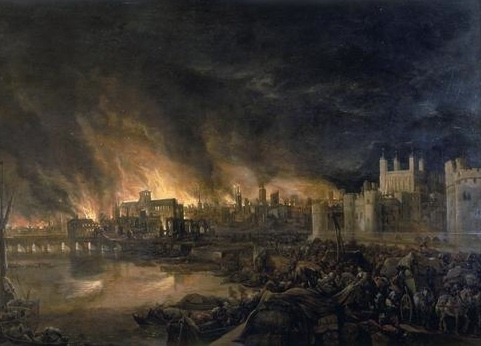 The Great Fire - by an unknown artist.
The Great Fire - by an unknown artist.Tower of London on the extreme right
London Bridge on the extreme left
St. Pauls on the left amidst the highest flames The Duke of York had hoped the Fleet Ditch would provide a natural fire break but nature worked against him and a strong wind blew from the east and the fire leapt the ditch to arrive in Fleet Street. But later on Tuesday, the wind dropped abruptly and the fire-breaks held…dare they hope?
The morning of Wednesday 5thSeptember (day 4) Pepys set off to inspect the city. He wrote of his ‘feet ready to burn’ such was the residual heat. Some indication of the damage was shown as he wrote about picking up a souvenir:“…a piece of glasse of [16thcentury] Mercer’s Chappell in the street…so melted and buckled with the heat of the fire like parchment.”
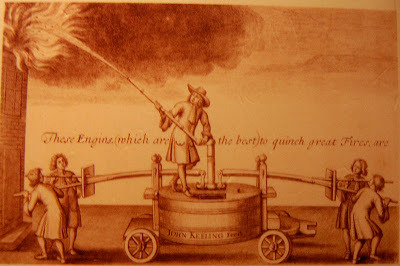 An early fire-engine - which would have been impotent
An early fire-engine - which would have been impotent against the power of the Great Fire. But the fire had largely done its worst and that night Pepys ‘slept a good night’ – the first since Sunday.
By all accounts on the Thursday, although the fire on burnt in localised areas, the heat radiating from scorched pavements and walls was fierce. No accurate figures existed of the number of deaths but although supposedly low, one wonders how many vagrants were burnt and went unaccounted for.
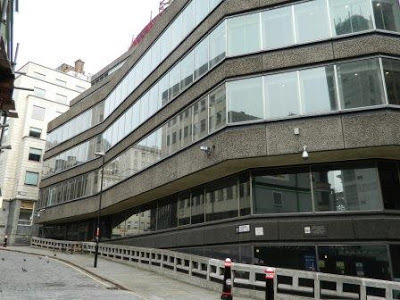 Pudding Lane in the modern day! After the fire, someone had to be blamed. A Frenchman, Robert Hubert, ‘a poor distracted wretch’ was executed as the culprit, but it later turned out to be a baker, Thomas Farynor of Pudding Lane. He had failed to put out his oven properly and an explosive aerosol of flour became exposed to the cinders, igniting the conflagration. In total, his negligence led to the destruction of the 13,000 homes, 87 churches and one cathedral that made up medieval London.
Pudding Lane in the modern day! After the fire, someone had to be blamed. A Frenchman, Robert Hubert, ‘a poor distracted wretch’ was executed as the culprit, but it later turned out to be a baker, Thomas Farynor of Pudding Lane. He had failed to put out his oven properly and an explosive aerosol of flour became exposed to the cinders, igniting the conflagration. In total, his negligence led to the destruction of the 13,000 homes, 87 churches and one cathedral that made up medieval London. 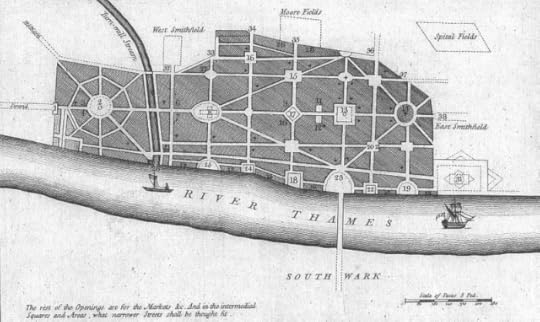 John Evelyn's plan for rebuilding London on a structured grid pattern.
John Evelyn's plan for rebuilding London on a structured grid pattern.This never happened as Londoner's swiftly started rebuilding on the site of their ruined homes.
Published on September 04, 2013 00:57
August 28, 2013
Southsea Castle, King Henry VIII and the Mary Rose
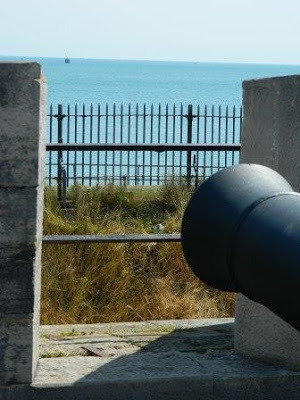 Did King Henry VIII stand on this spot to
Did King Henry VIII stand on this spot to watch the Mary Rose sink...‘Your Highness’s new fortress here…may be called a castle, both for the compass, strength and beauty…and marvellously praised of all men that have seen it.’
Sir Anthony Knyvet, 22 Oct 1544
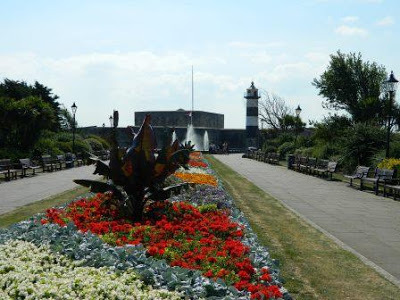 Southsea Castle (centre, in the distance to the left of the lighthouse)
Southsea Castle (centre, in the distance to the left of the lighthouse)Seen form Southsea Common. On a perfect summer’s day, I fed my history addiction by visiting Southsea Castle and then the Mary Rose museum, Portsmouth.
Indeed, Southsea Castle is perhaps most well-known for being the place from which, on 19th July, 1545, King Henry VIII witnessed the sinking of the Mary Rose. My aim was to revisit the spot where Henry stood…
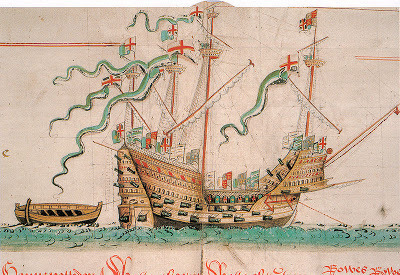 The Mary Rose - flying green and white Tudor pennants. Southsea Castle was built to Henry VIII’s own design, in 1544. He was concerned about a French invasion of Portsmouth and positioned his new castle, or fortress, at a strategic site overlooking the Solent (the stretch of water between the mainland and the Isle of Wight). It commanded a stretch of deep water where ships passed closest to shore on their way into the important naval base of Portsmouth.
The Mary Rose - flying green and white Tudor pennants. Southsea Castle was built to Henry VIII’s own design, in 1544. He was concerned about a French invasion of Portsmouth and positioned his new castle, or fortress, at a strategic site overlooking the Solent (the stretch of water between the mainland and the Isle of Wight). It commanded a stretch of deep water where ships passed closest to shore on their way into the important naval base of Portsmouth. 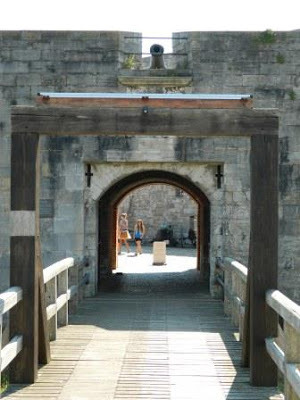 The entrance to Southsea Castle.
The entrance to Southsea Castle.Henry appointed Sir Anthony Knyvet, Governor of Portsmouth, to oversee the construction. Knyvet took care to report regularly to his majesty. In one letter, some idea of the pressure to complete the build is hinted at when he bemoans a 10 day period in June 1544 when the weather was too poor to ship building supplies over from the Isle of Wight. Just a week later he reports construction will be far enough advanced, 12 days hence, to support weaponry. However, on 8th July he wrote again, anxious to correct the king who had been told the castle was fully defensible, “the which [sic] is not.” Again, supplies seem to have been the problem:“Only a small quantity of gunpowder and the two sacres [small brass canon firing 6 pound shot]had been delivered, along with a good store of bows, arrows, bills and pikes.”
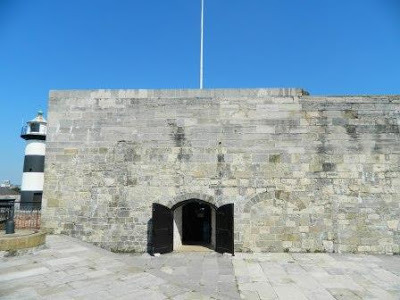 The keep - an original part of Henry's Castle.Keen as he was to have the new fortification finished, Henry was slow to send money for wages and materials, and Knyvet was forced to apply for more funds on several occasions. Over the six months it took to build Southsea Castle 3,000GBP was spent, of which 1,300 GBP came from the dissolution of the monasteries.
The keep - an original part of Henry's Castle.Keen as he was to have the new fortification finished, Henry was slow to send money for wages and materials, and Knyvet was forced to apply for more funds on several occasions. Over the six months it took to build Southsea Castle 3,000GBP was spent, of which 1,300 GBP came from the dissolution of the monasteries. ‘I dare say your Majesty had never so great a piece of work done and so substantial, in so little time, as all skilful men that have seen it do report.’Sir Anthony Knyvet.
When completed Knyvet wrote to Lord Wriothesely, the High Chancellor, that never had such a fortress been built at so little cost. He also hoped the king would be pleased “which was of his Majesty’s own device” – that is to say, Henry himself had been responsible for the design.
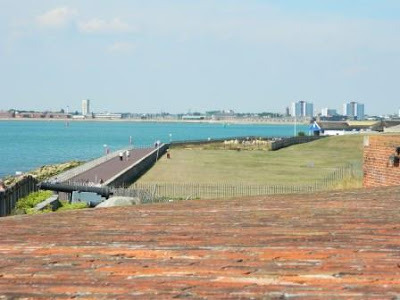 Standing on the ramparts, looking west across the entrance
Standing on the ramparts, looking west across the entranceto Portsmouth harbour.Over the centuries the castle has been adapted and expanded, to meet changing defence needs. Indeed, Charles II visited in 1683 to inspect improvements made by his chief engineer, Sir Bernard de Gomme. Charles’ coat of arms can be seen carved in stone above the castle’s entrance.
It is hard to imagine how Southsea Castle looked in Tudor times but part of Henry’s original castle can still be seen at the keep, as well as East and West gun platforms. The keep, its walls up to 3 metres thick, was blissfully cool inside on the hot summer’s day of my visit. Whilst I’m not convinced I found the exact spot where King Henry VIII stood on that fateful day in 1545 – I hope the photos give some flavour of the view. Most of the photographs were taken from the ramparts – which were built in the early 1800’s as canon placements during the Napoleonic wars.
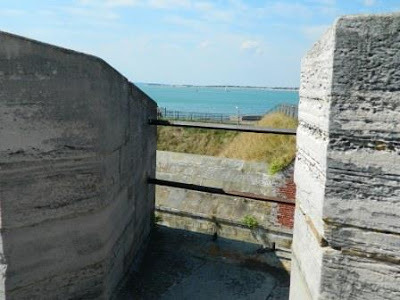 View from the keep over-looking the Solent.
View from the keep over-looking the Solent.
Published on August 28, 2013 02:15
August 21, 2013
The Language of Dogs: Cur and Tyke
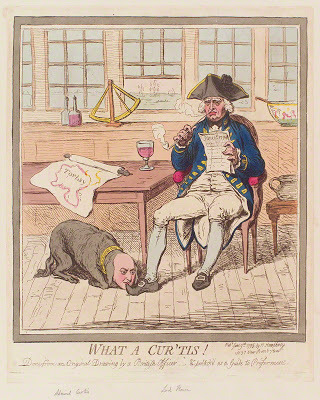 18th century Cheezburger? Satirical etching that portrays Sir Roger Curtis as Lord Howe's dog The association between man and dog is an ancient one, perhaps even extending back beyond the birth of language as we know it. But the words used to describe our canine companions, have changed and evolved, every bit as much as the dogs themselves. My next couple of blog posts consider some of the terms used to refer to dogs over the centuries.
18th century Cheezburger? Satirical etching that portrays Sir Roger Curtis as Lord Howe's dog The association between man and dog is an ancient one, perhaps even extending back beyond the birth of language as we know it. But the words used to describe our canine companions, have changed and evolved, every bit as much as the dogs themselves. My next couple of blog posts consider some of the terms used to refer to dogs over the centuries. 
The earliest way of referring to canines was either as a dog or hound.‘Dog’ is one of a group of old English words ending in ‘-g’ that refer to animals – such as pig, hog, stag and even earwig! ‘Hound’ has common roots in a number of European countries – such as German ‘hund’ and the Dutch ‘hond’. In the Middle Ages especially, there were a number of disparaging terms for dog. According to the Oxford English Dictionary a ‘cur’ is defined as: A dog: a worthless, low-bred, or snappish dog. Formerly (and still sometimes dialectally) applied without depreciation, esp. to a watch-dog or shepherd's dog.
The first recorded usage of ‘cur’ is in by Chaucer in 1385, and mentions crop up in literature from pretty much every century. ‘The most Staunch and best Hunting Hounds; (all babling and flying Curs being left at home).’ 1684 R. Howlett ‘I am hunted away..by every barking Curr about the House.’1712 J. Arbuthnot
 From around the 17th century, the word ‘cur’ became used as a term of contempt for certain people:
Cur: Surly, ill-bred, low, or cowardly fellow
OED,
From around the 17th century, the word ‘cur’ became used as a term of contempt for certain people:
Cur: Surly, ill-bred, low, or cowardly fellow
OED, As cited is this quote from ‘A Midsummer Night’s Dream’.‘Out dog, out curre: thou driu'st me past the bounds Of maidens patience’Shakespeare, 1600
And also ‘Coriolanus’ ‘What would you have, you Curres, That like nor Peace, nor Warre?’
Somewhat confusingly, the OED definition states that a ‘cur’ could also mean a guard dog.Cur, a good, sharp watchdog. The word does not refer, in the least to low breeding.1884 R. Holland – Words from the County of Chester.
 An alternative word dating from the Middle Ages with similar meaning to cur is ‘tyke’ – this was especially associated with the Yorkshire dialect, where a ‘tyke’ could be used interchangeably with ‘dog’. Other counties were not so forgiving and the term was largely disparaging.
Tyke: A dog; usually in depreciation or contempt, a low-bred or coarse dog, a cur, a mongrel.
OED?c1225—1884
An alternative word dating from the Middle Ages with similar meaning to cur is ‘tyke’ – this was especially associated with the Yorkshire dialect, where a ‘tyke’ could be used interchangeably with ‘dog’. Other counties were not so forgiving and the term was largely disparaging.
Tyke: A dog; usually in depreciation or contempt, a low-bred or coarse dog, a cur, a mongrel.
OED?c1225—1884
References can be found in writings from the 15th century onwards.‘He barkis lyk an midding tyk’1513 W. DUNBAR and my favourite;‘The mad randy gipsy, that had..been hounded like a stray tike from parish to parish.’1829 SCOTT
 And finally, it is interesting to reflect that more modern expressions such as dog-sitter, dog-napper and doggy-day-care imply a similar importance to a child. So next week, I look at some of the affectionate language used through the centuries to refer to our lap-dog companions.
And finally, it is interesting to reflect that more modern expressions such as dog-sitter, dog-napper and doggy-day-care imply a similar importance to a child. So next week, I look at some of the affectionate language used through the centuries to refer to our lap-dog companions.
Published on August 21, 2013 02:02
August 11, 2013
English Customs: The Devil's Nutting Day
Did you know that September 14th is ‘the Devil’s Nutting Day’?
 An English folk tradition dating back over 450 years connects Holy Cross Day on September 14th with another custom called ‘nutting’. Originally, the feast day took place to commemorate a piece of the True Cross that was recovered and stored safely in Constantinople, in 629 BC. But as is the nature of events, in 1560 some Eton schoolboys were granted a half-day holiday on Holy Cross Day and decided to amuse themselves by gathering nuts.
An English folk tradition dating back over 450 years connects Holy Cross Day on September 14th with another custom called ‘nutting’. Originally, the feast day took place to commemorate a piece of the True Cross that was recovered and stored safely in Constantinople, in 629 BC. But as is the nature of events, in 1560 some Eton schoolboys were granted a half-day holiday on Holy Cross Day and decided to amuse themselves by gathering nuts.
“All the youths are now a-nutting gone.”Grim the Collier of Croydon- a popular 17th century play.
 The nuts in question are hazelnuts with the nuts ripening in hedgerows from September onwards. Hazelnuts have many links to folk lore and have associations with wisdom and power (it is a hazel rod that should be used for water divining) The phrase ‘going a nutting’ crops up regularly in 17th century songs and plays, and was a by word for sex and seduction – young people being alone in the woods ...! Such was the link between collecting nuts and more risque activities that a popular expression in 1660 was:“A good year for nuts, a good year for babies.”
The nuts in question are hazelnuts with the nuts ripening in hedgerows from September onwards. Hazelnuts have many links to folk lore and have associations with wisdom and power (it is a hazel rod that should be used for water divining) The phrase ‘going a nutting’ crops up regularly in 17th century songs and plays, and was a by word for sex and seduction – young people being alone in the woods ...! Such was the link between collecting nuts and more risque activities that a popular expression in 1660 was:“A good year for nuts, a good year for babies.”
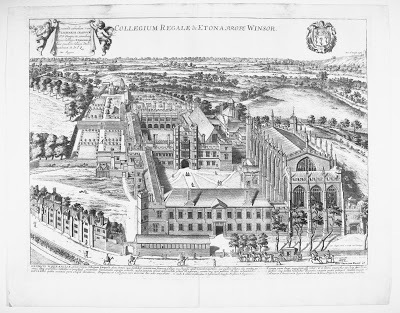 Eton College in 1690Over the years the Devil became associated with the collecting of nuts, although exactly how these two things became linked is not clear, (perhaps parents invoked the devil to discourage their offspring from getting pregnant!) Country folk were warned not to go nutting on Sundays as the Devil would be disguised as a gentleman and trick them by offering to pull down the top branches.
Eton College in 1690Over the years the Devil became associated with the collecting of nuts, although exactly how these two things became linked is not clear, (perhaps parents invoked the devil to discourage their offspring from getting pregnant!) Country folk were warned not to go nutting on Sundays as the Devil would be disguised as a gentleman and trick them by offering to pull down the top branches.
Another time the Devil was likely to be abroad was Holy Cross Day, as poet John Clare, writes in 1825:“On Holy Rood [Cross] Day it is faithfully…believed both by old and young that the Devil goes a –nutting…I have heard many people affirm that they thought it a tale until they ventured into the woods on that day when they smelt such a strong smell of brimstone as nearly stifled them before they could escape…”
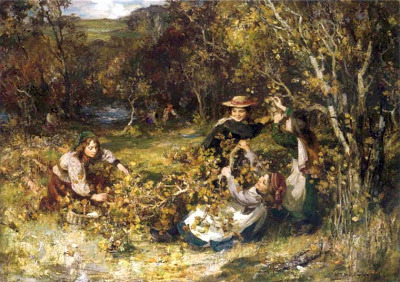 Victorians collecting nuts.And finally, in Warwickshire there is a legend that a particular hill, The Devil’s Nightcap near Alcester, was formed when the Devil met the Virgin Mary on the road and dropped his nutting bag in fright! This blog post is part of an Absolute Write blog hop. To read the other posts in this hop follow the links below: Devil Child - a short story
Victorians collecting nuts.And finally, in Warwickshire there is a legend that a particular hill, The Devil’s Nightcap near Alcester, was formed when the Devil met the Virgin Mary on the road and dropped his nutting bag in fright! This blog post is part of an Absolute Write blog hop. To read the other posts in this hop follow the links below: Devil Child - a short story
DevilChilde
Lurking Musings
Morning Glory
D R Slaten
Do Not Tamper With...
Lizzy's Dark Fiction
Tara Quan
 An English folk tradition dating back over 450 years connects Holy Cross Day on September 14th with another custom called ‘nutting’. Originally, the feast day took place to commemorate a piece of the True Cross that was recovered and stored safely in Constantinople, in 629 BC. But as is the nature of events, in 1560 some Eton schoolboys were granted a half-day holiday on Holy Cross Day and decided to amuse themselves by gathering nuts.
An English folk tradition dating back over 450 years connects Holy Cross Day on September 14th with another custom called ‘nutting’. Originally, the feast day took place to commemorate a piece of the True Cross that was recovered and stored safely in Constantinople, in 629 BC. But as is the nature of events, in 1560 some Eton schoolboys were granted a half-day holiday on Holy Cross Day and decided to amuse themselves by gathering nuts. “All the youths are now a-nutting gone.”Grim the Collier of Croydon- a popular 17th century play.
 The nuts in question are hazelnuts with the nuts ripening in hedgerows from September onwards. Hazelnuts have many links to folk lore and have associations with wisdom and power (it is a hazel rod that should be used for water divining) The phrase ‘going a nutting’ crops up regularly in 17th century songs and plays, and was a by word for sex and seduction – young people being alone in the woods ...! Such was the link between collecting nuts and more risque activities that a popular expression in 1660 was:“A good year for nuts, a good year for babies.”
The nuts in question are hazelnuts with the nuts ripening in hedgerows from September onwards. Hazelnuts have many links to folk lore and have associations with wisdom and power (it is a hazel rod that should be used for water divining) The phrase ‘going a nutting’ crops up regularly in 17th century songs and plays, and was a by word for sex and seduction – young people being alone in the woods ...! Such was the link between collecting nuts and more risque activities that a popular expression in 1660 was:“A good year for nuts, a good year for babies.” Eton College in 1690Over the years the Devil became associated with the collecting of nuts, although exactly how these two things became linked is not clear, (perhaps parents invoked the devil to discourage their offspring from getting pregnant!) Country folk were warned not to go nutting on Sundays as the Devil would be disguised as a gentleman and trick them by offering to pull down the top branches.
Eton College in 1690Over the years the Devil became associated with the collecting of nuts, although exactly how these two things became linked is not clear, (perhaps parents invoked the devil to discourage their offspring from getting pregnant!) Country folk were warned not to go nutting on Sundays as the Devil would be disguised as a gentleman and trick them by offering to pull down the top branches. Another time the Devil was likely to be abroad was Holy Cross Day, as poet John Clare, writes in 1825:“On Holy Rood [Cross] Day it is faithfully…believed both by old and young that the Devil goes a –nutting…I have heard many people affirm that they thought it a tale until they ventured into the woods on that day when they smelt such a strong smell of brimstone as nearly stifled them before they could escape…”
 Victorians collecting nuts.And finally, in Warwickshire there is a legend that a particular hill, The Devil’s Nightcap near Alcester, was formed when the Devil met the Virgin Mary on the road and dropped his nutting bag in fright! This blog post is part of an Absolute Write blog hop. To read the other posts in this hop follow the links below: Devil Child - a short story
Victorians collecting nuts.And finally, in Warwickshire there is a legend that a particular hill, The Devil’s Nightcap near Alcester, was formed when the Devil met the Virgin Mary on the road and dropped his nutting bag in fright! This blog post is part of an Absolute Write blog hop. To read the other posts in this hop follow the links below: Devil Child - a short storyDevilChilde
Lurking Musings
Morning Glory
D R Slaten
Do Not Tamper With...
Lizzy's Dark Fiction
Tara Quan
Published on August 11, 2013 11:56
August 7, 2013
In Praise of Dogs - Words from History
"The best thing about man is the dog." Voltaire
Man’s best friend – the dog.
 U.S. Navy photo by Petty Officer 2nd Class John F. Looney
U.S. Navy photo by Petty Officer 2nd Class John F. Looney The War Dog Cemetery, near Naval Base GuamOur canine companions have had a long journey from guard and working animal to lap dog and friend. It is quite a transition from Shakespeare using the noun ‘dog’ interchangeably with ‘cur’ to denote an untrustworthy person, on to Benjamin Franklin writing in 1738 who said:
"There are three faithful friends—an old wife, an old dog, and ready money."
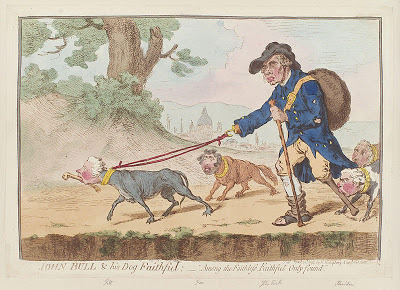 John Bull and his dog, Faithful.
John Bull and his dog, Faithful.A play on the politicians of the day.The theme of dogs as faithful is frequently repeated such as in this quote from Sir Walter Scott in 1825:"Recollect that the Almighty, who gave the dog to be companion of our pleasures and our toils, hath invested him with a nature nobleand incapable of deceit."
And in 1720, John Gay writes in “An Elegy on a Lap-dog” He's dead. Oh lay him gently in the ground!
And may his tomb be by this verse renown'd.
Here Shock, the pride of all his kind, is laid;
Who fawned like man, but ne'er like man betray'd.
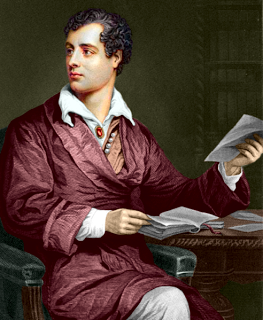 Lord ByronIn this quote from Lord Byron, 1808, the death of a faithful canine companion elicited words of praise:The poor dog, in life the firmest friend
Lord ByronIn this quote from Lord Byron, 1808, the death of a faithful canine companion elicited words of praise:The poor dog, in life the firmest friend The first to welcome, foremost to defend
 King Charles IIHowever, this devotion was not welcomed by everyone, especially when the dog was a distraction. King Charles II’s love of dogs is well documents, but when he paid them too much attention during a meeting, a courtier was heard to remark:"God save your Majesty, but God damn your dogs."
King Charles IIHowever, this devotion was not welcomed by everyone, especially when the dog was a distraction. King Charles II’s love of dogs is well documents, but when he paid them too much attention during a meeting, a courtier was heard to remark:"God save your Majesty, but God damn your dogs."
Samuel Pepys records another encounter with Charles II and “A dog the King loved” whilst travelling on a barge. The dog seemingly fouled the boat, “which made us laugh, and me think that a King and all that belongs to him are but just as others are.” However, Pepys sense of humour did not extend to his wife’s dog, whom he threatened to “Fling out of the window” if he soiled in the house again.
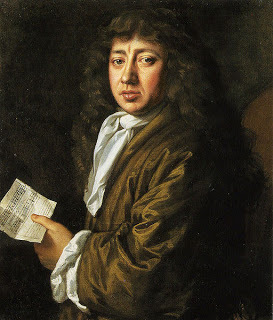 Samuel PepysAnd finally, in praise of dogs:"Histories are more full of examples of fidelity of dogs than of friends." Alexander Pope
Samuel PepysAnd finally, in praise of dogs:"Histories are more full of examples of fidelity of dogs than of friends." Alexander Pope "The dog puts the Christian to shame."Robert Burns
As a cat lover, I concede that dogs can be (perhaps) more faithful, but as to which species makes the better companion – my vote goes to cats because they can chose not to befriend you. So, what is your choice: cat or dog?

Published on August 07, 2013 01:07
July 31, 2013
Fictional Cats
How are cats portrayed in fiction?
Those of you that visit this blog regularly will have worked out that I’m a bit obsessed by all things feline. Today I feed that obsession by considering how cats are portrayed in literature.
 A good starting point is Rudyard Kipling. He wrote a ‘Just So’ story that captures the essential qualities of the cat’s character. In ‘The Cat that Walked by Himself’ – the cat bargains with the woman to drink her milk and sleep by her fire, but in return will do exactly as he pleases! Those cat lovers amongst you will sympathise with that scenario!
A good starting point is Rudyard Kipling. He wrote a ‘Just So’ story that captures the essential qualities of the cat’s character. In ‘The Cat that Walked by Himself’ – the cat bargains with the woman to drink her milk and sleep by her fire, but in return will do exactly as he pleases! Those cat lovers amongst you will sympathise with that scenario!
Stephen King has the same perception of cats as independent creatures.
“Cats were the gangsters of the animal world, living outside the law and often dying there. There were a great many of them who never grew old by the fire.”
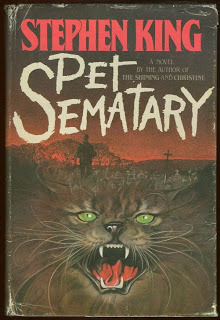 First edition copy of Pet SemataryPet Sematary [nb for the English readers amongst you, this spelling of ‘cemetery’ jars terribly, but what can I do!] Pet Sematary is the story a cat ‘Church’ (Winston Churchill) who is killed in a traffic accident. He is buried in the sematary/ cemetery of the title, but returns home… “Sometimes dead is better”
First edition copy of Pet SemataryPet Sematary [nb for the English readers amongst you, this spelling of ‘cemetery’ jars terribly, but what can I do!] Pet Sematary is the story a cat ‘Church’ (Winston Churchill) who is killed in a traffic accident. He is buried in the sematary/ cemetery of the title, but returns home… “Sometimes dead is better”
The reaction of Ellie, that cat’s young owner, to his death, reflects something of the bond between cat and owner.
“He’s my cat! He’s not God’s cat! Let God have his own cat! Let God have all the damn old cats He wants, and kill them all! Church is mine!”
Hilary Mantel in one of my favourite novels, Wolf Hall, beautifully describes that gentle pleasure to be had whilst watching a cat. This passage describes an interaction between the powerful political manipulator, Thomas Cromwell, and his cat, Marlinspike.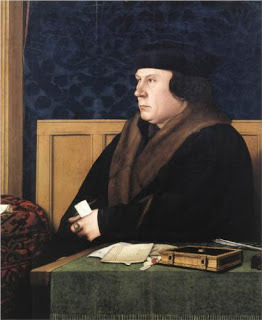 Portrait of Thomas Cromwell
Portrait of Thomas Cromwell
by Hans Holbein.“A cat may look at a king,” he [Cromwell]says. He is cradling Marlinspike in his arms, and talking to Thomas Avery, the boy he’s teaching his trade…
…He puts the cat down, opens the bag.He fishes up on a finger a string of rosary beads; for show says Avery, and he says, good boy. Marlinspike leaps on to his desk; he peers into the bag, dabbing with a paw. “The only mice in there are sugar ones.” The boy [Avery]pulls the cat’s ears, tussles with him. “We don’t have any little pets in Master Vaughan’s house.”
In J K Rowling’s novel, Harry Potter and the Prisoner of Azkaban, the author creates Crookshanks, Hermione Granger’s cat. Her pet is half cat, half Kneazle with a lion-like appearance and has the distinctive quality of recognising untrustworthy people (even when transfigured.) Hermione bought Crookshanks from the Magical Menagerie in Diagon Alley where he had been languishing because, ‘Nobody wanted him.’
I love this interaction between Ron (obviously not a cat person) and Hermione.
Ron: "You bought that monster?" Hermione: "He's gorgeous, isn't he?" Ron: "Hermione, that thing nearly scalped me!" Roald Dahl also tackles the conflict between those for and those against cats, in his book, Edward the Conqueror. In this tale a wife rescues a stray cat from a bonfire and then discovers he appreciates her piano playing. She becomes convinced that the cat in the reincarnation of the composer, Franz Liszt, much to the chagrin of her cat-hating husband. The husband-wife bond is sorely tested when he becomes jealous of the cat and attempts to dispose of the animal…
Roald Dahl also tackles the conflict between those for and those against cats, in his book, Edward the Conqueror. In this tale a wife rescues a stray cat from a bonfire and then discovers he appreciates her piano playing. She becomes convinced that the cat in the reincarnation of the composer, Franz Liszt, much to the chagrin of her cat-hating husband. The husband-wife bond is sorely tested when he becomes jealous of the cat and attempts to dispose of the animal…
 Charles Dickens also mentions cats in his novels and several characters, from Lady Jane, to Mr Jellyby and Mrs Pipchin have feline companions. Perhaps more chilling are the references to cats finding their way into the human food chain!
Charles Dickens also mentions cats in his novels and several characters, from Lady Jane, to Mr Jellyby and Mrs Pipchin have feline companions. Perhaps more chilling are the references to cats finding their way into the human food chain!
‘Veal pie,' said Mr. Weller, soliloquizing, as he arranged the eatables on the grass. 'Very good thing is veal pie, when you know the lady as made it, and is quite sure it ain't kittens … they're so like veal that the very piemen themselves don't know the difference.'
And:'I [Sam Weller]lodged in the same house with a pieman once…make pies out o’anything, he could. ‘What a number o’cats you keep, Mr Brooks,’ says I ‘You must be very fond of cats’ says I. ‘Other people is,’ says he a-winkin’ at me…and wispering in my ear, ‘don’t mention this again…but it’s the seasonin’ as does it,’ says he, a-pointin’ to a very nice little tabby kitten, ‘and I seasons ‘em for beefsteak, weal or kidney, ‘cording to the demand.’Pickwick Papers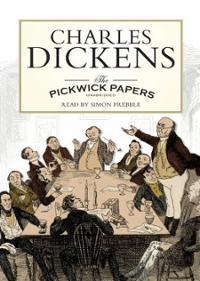 And finally, on a more cheerful note, in my latest release,
Verity's Lie
, - our heroine learns something unexpected about the gruff Lord Ryevale:
And finally, on a more cheerful note, in my latest release,
Verity's Lie
, - our heroine learns something unexpected about the gruff Lord Ryevale:
Verity stepped into a bright hallway that smelt of sweet peas. A jute runner covered the flagstones and picture frames lined the walls. There was a lack of fussiness and sense of refined simplicity that appealed to Verity. Added to that, a plump back cat came padding along the corridor, mewling for attention. "Gibbe, you cheeky boy. I might have known you'd appear when visitors arrive...making out as if no one feeds you." The cat made straight for Lord Ryevale and rubbed around his ankles whilst purring ecstatically. His lordship stooped to rub Gibbe's ears, the purrs growing ever louder. Seeing this softer side of Ryevale moved Verity beyond words. "You like that, don’t you? Is that the spot?" A soft light entered Ryevale's eye. Verity watched wide-eyed as the cat rolled over to display his ample belly whilst Ryevale clicked his tongue and made gooey noises. It was Mrs Featherstone who interrupted this touching scene. "Now Gibbe, leave his lordship alone. Come into the kitchen and I'll find you some oysters. Lord Ryevale, dear, Miss Foster is in the studio. Can you see yourself up?" "Indeed." Ryevale glanced around defensively, as if remembering Verity's presence. "This way, Miss Verrinder."

Those of you that visit this blog regularly will have worked out that I’m a bit obsessed by all things feline. Today I feed that obsession by considering how cats are portrayed in literature.
 A good starting point is Rudyard Kipling. He wrote a ‘Just So’ story that captures the essential qualities of the cat’s character. In ‘The Cat that Walked by Himself’ – the cat bargains with the woman to drink her milk and sleep by her fire, but in return will do exactly as he pleases! Those cat lovers amongst you will sympathise with that scenario!
A good starting point is Rudyard Kipling. He wrote a ‘Just So’ story that captures the essential qualities of the cat’s character. In ‘The Cat that Walked by Himself’ – the cat bargains with the woman to drink her milk and sleep by her fire, but in return will do exactly as he pleases! Those cat lovers amongst you will sympathise with that scenario! Stephen King has the same perception of cats as independent creatures.
“Cats were the gangsters of the animal world, living outside the law and often dying there. There were a great many of them who never grew old by the fire.”
 First edition copy of Pet SemataryPet Sematary [nb for the English readers amongst you, this spelling of ‘cemetery’ jars terribly, but what can I do!] Pet Sematary is the story a cat ‘Church’ (Winston Churchill) who is killed in a traffic accident. He is buried in the sematary/ cemetery of the title, but returns home… “Sometimes dead is better”
First edition copy of Pet SemataryPet Sematary [nb for the English readers amongst you, this spelling of ‘cemetery’ jars terribly, but what can I do!] Pet Sematary is the story a cat ‘Church’ (Winston Churchill) who is killed in a traffic accident. He is buried in the sematary/ cemetery of the title, but returns home… “Sometimes dead is better”The reaction of Ellie, that cat’s young owner, to his death, reflects something of the bond between cat and owner.
“He’s my cat! He’s not God’s cat! Let God have his own cat! Let God have all the damn old cats He wants, and kill them all! Church is mine!”
Hilary Mantel in one of my favourite novels, Wolf Hall, beautifully describes that gentle pleasure to be had whilst watching a cat. This passage describes an interaction between the powerful political manipulator, Thomas Cromwell, and his cat, Marlinspike.
 Portrait of Thomas Cromwell
Portrait of Thomas Cromwellby Hans Holbein.“A cat may look at a king,” he [Cromwell]says. He is cradling Marlinspike in his arms, and talking to Thomas Avery, the boy he’s teaching his trade…
…He puts the cat down, opens the bag.He fishes up on a finger a string of rosary beads; for show says Avery, and he says, good boy. Marlinspike leaps on to his desk; he peers into the bag, dabbing with a paw. “The only mice in there are sugar ones.” The boy [Avery]pulls the cat’s ears, tussles with him. “We don’t have any little pets in Master Vaughan’s house.”
In J K Rowling’s novel, Harry Potter and the Prisoner of Azkaban, the author creates Crookshanks, Hermione Granger’s cat. Her pet is half cat, half Kneazle with a lion-like appearance and has the distinctive quality of recognising untrustworthy people (even when transfigured.) Hermione bought Crookshanks from the Magical Menagerie in Diagon Alley where he had been languishing because, ‘Nobody wanted him.’
I love this interaction between Ron (obviously not a cat person) and Hermione.
Ron: "You bought that monster?" Hermione: "He's gorgeous, isn't he?" Ron: "Hermione, that thing nearly scalped me!"
 Roald Dahl also tackles the conflict between those for and those against cats, in his book, Edward the Conqueror. In this tale a wife rescues a stray cat from a bonfire and then discovers he appreciates her piano playing. She becomes convinced that the cat in the reincarnation of the composer, Franz Liszt, much to the chagrin of her cat-hating husband. The husband-wife bond is sorely tested when he becomes jealous of the cat and attempts to dispose of the animal…
Roald Dahl also tackles the conflict between those for and those against cats, in his book, Edward the Conqueror. In this tale a wife rescues a stray cat from a bonfire and then discovers he appreciates her piano playing. She becomes convinced that the cat in the reincarnation of the composer, Franz Liszt, much to the chagrin of her cat-hating husband. The husband-wife bond is sorely tested when he becomes jealous of the cat and attempts to dispose of the animal… Charles Dickens also mentions cats in his novels and several characters, from Lady Jane, to Mr Jellyby and Mrs Pipchin have feline companions. Perhaps more chilling are the references to cats finding their way into the human food chain!
Charles Dickens also mentions cats in his novels and several characters, from Lady Jane, to Mr Jellyby and Mrs Pipchin have feline companions. Perhaps more chilling are the references to cats finding their way into the human food chain!‘Veal pie,' said Mr. Weller, soliloquizing, as he arranged the eatables on the grass. 'Very good thing is veal pie, when you know the lady as made it, and is quite sure it ain't kittens … they're so like veal that the very piemen themselves don't know the difference.'
And:'I [Sam Weller]lodged in the same house with a pieman once…make pies out o’anything, he could. ‘What a number o’cats you keep, Mr Brooks,’ says I ‘You must be very fond of cats’ says I. ‘Other people is,’ says he a-winkin’ at me…and wispering in my ear, ‘don’t mention this again…but it’s the seasonin’ as does it,’ says he, a-pointin’ to a very nice little tabby kitten, ‘and I seasons ‘em for beefsteak, weal or kidney, ‘cording to the demand.’Pickwick Papers
 And finally, on a more cheerful note, in my latest release,
Verity's Lie
, - our heroine learns something unexpected about the gruff Lord Ryevale:
And finally, on a more cheerful note, in my latest release,
Verity's Lie
, - our heroine learns something unexpected about the gruff Lord Ryevale:Verity stepped into a bright hallway that smelt of sweet peas. A jute runner covered the flagstones and picture frames lined the walls. There was a lack of fussiness and sense of refined simplicity that appealed to Verity. Added to that, a plump back cat came padding along the corridor, mewling for attention. "Gibbe, you cheeky boy. I might have known you'd appear when visitors arrive...making out as if no one feeds you." The cat made straight for Lord Ryevale and rubbed around his ankles whilst purring ecstatically. His lordship stooped to rub Gibbe's ears, the purrs growing ever louder. Seeing this softer side of Ryevale moved Verity beyond words. "You like that, don’t you? Is that the spot?" A soft light entered Ryevale's eye. Verity watched wide-eyed as the cat rolled over to display his ample belly whilst Ryevale clicked his tongue and made gooey noises. It was Mrs Featherstone who interrupted this touching scene. "Now Gibbe, leave his lordship alone. Come into the kitchen and I'll find you some oysters. Lord Ryevale, dear, Miss Foster is in the studio. Can you see yourself up?" "Indeed." Ryevale glanced around defensively, as if remembering Verity's presence. "This way, Miss Verrinder."

Published on July 31, 2013 01:52
July 21, 2013
Performing for the King - at the Banqueting House
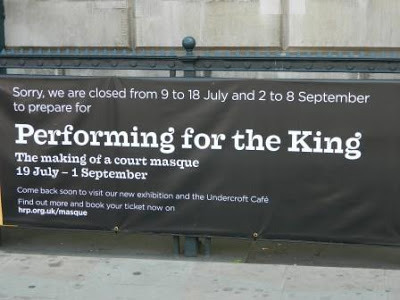 Last Thursday I was fortunate enough to preview a new exhibition ‘Performing for theKing’ at London’s Banqueting House, Whitehall. To be fair, ‘exhibition’ is too static a word to describe this event since there is movement and music, costumes to try on as well as period characters that mingle with the visitors. With deliberately subdued lighting to recreate the atmosphere of 17th century candlelight, this is anything but a walk-and-read display.
Last Thursday I was fortunate enough to preview a new exhibition ‘Performing for theKing’ at London’s Banqueting House, Whitehall. To be fair, ‘exhibition’ is too static a word to describe this event since there is movement and music, costumes to try on as well as period characters that mingle with the visitors. With deliberately subdued lighting to recreate the atmosphere of 17th century candlelight, this is anything but a walk-and-read display.  A model of Inigo Jones's contraption for lowering the queen
A model of Inigo Jones's contraption for lowering the queenout of a cloudThe aspect that most fired my imagination were Inigo Jones set designs and his use of early special effects. But first, a little background about ‘Performing for the King’ the creation of a court masque. The aim of the Banqueting House’s curator, Jane Spooner, is to give the visitor a sense of what went on behind the scenes at a 17th century masque and a taste of the atmosphere.
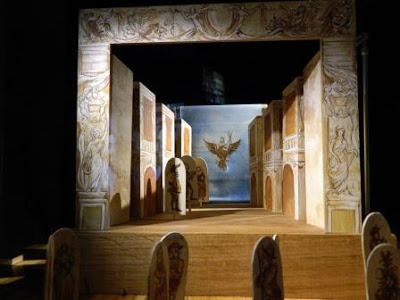 Jones' innovative use of newly 'discovered' perspective. To illustrate this Jane recreates part of the 1620 production of Tempe Restored. This masque (a play with music and dancing) was a sort of Stuart propaganda piece, pushing the message of the Stuart’s as a uniting monarchy, bringing peace to a troubled England and Scotland. The extravagant spectacle was designed to amaze and awe, but of course this carried a commensurate price tag. For the ordinary working man looking in from the outside, the cost of such masques must have rubbed salt into the wound of their day-to-day hardships.
Jones' innovative use of newly 'discovered' perspective. To illustrate this Jane recreates part of the 1620 production of Tempe Restored. This masque (a play with music and dancing) was a sort of Stuart propaganda piece, pushing the message of the Stuart’s as a uniting monarchy, bringing peace to a troubled England and Scotland. The extravagant spectacle was designed to amaze and awe, but of course this carried a commensurate price tag. For the ordinary working man looking in from the outside, the cost of such masques must have rubbed salt into the wound of their day-to-day hardships. 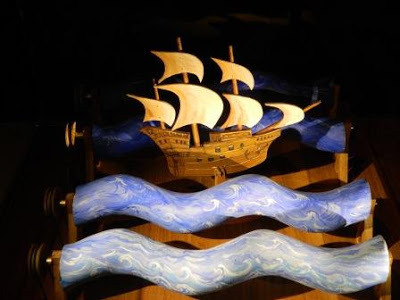 Another of Inigo Jones' set designs. One of the most eye-catching things about Tempe Restored was the innovative set design by Inigo Jones. For maximum impact the main players (the King and Queen playing the parts of Apollo and Diana) were to descend from the heavens in a cloud. To achieve this Ingio Jones created a piece of scenery worked by pulleys and powered by teams of strong men. Don’t forget this was in a time before hydraulics and engines, so any heavy lifting had to be done by muscle power. These moving elements were heavy and dangerous - and made a lot of noise which was disguised by playing loud music.
Another of Inigo Jones' set designs. One of the most eye-catching things about Tempe Restored was the innovative set design by Inigo Jones. For maximum impact the main players (the King and Queen playing the parts of Apollo and Diana) were to descend from the heavens in a cloud. To achieve this Ingio Jones created a piece of scenery worked by pulleys and powered by teams of strong men. Don’t forget this was in a time before hydraulics and engines, so any heavy lifting had to be done by muscle power. These moving elements were heavy and dangerous - and made a lot of noise which was disguised by playing loud music. 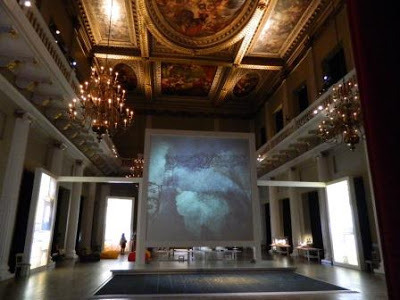 The screen before which the actors performInigo Jones used tricks of perspective, (a recent ‘invention’), as well as layering, lighting and masking to transform a 2-D stage into a 3-D drama. The clever people at the Banqueting House give the visitor a feel for these effects with Monty Pythonesque slides of scenery projected on the stage backdrop as the performance takes place.
The screen before which the actors performInigo Jones used tricks of perspective, (a recent ‘invention’), as well as layering, lighting and masking to transform a 2-D stage into a 3-D drama. The clever people at the Banqueting House give the visitor a feel for these effects with Monty Pythonesque slides of scenery projected on the stage backdrop as the performance takes place.
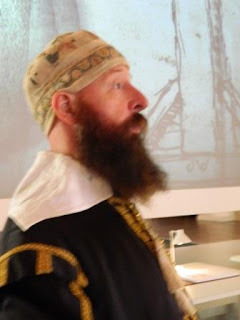 The great man himself - Inigo Jones.
The great man himself - Inigo Jones.Meet him at Performing for the King!
To find out more click on Performing for the King - open from July 19th to September 1st 2013.
You can also chat to Inigo Jones himself on Twitter – simply tweet @ask_inigo and include a hashtag #man #woman #boy or #girl – to enrol yourself a character in the masque.
Once again, I’d like to extend my thanks to the Historic Royal Palaces organisation, and especially John Shevlin, for inviting me to this preview.
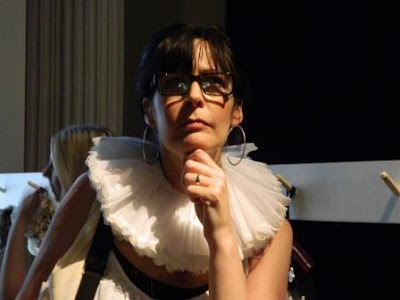 Even I got into the spirit of things and tried on a ruff!
Even I got into the spirit of things and tried on a ruff!
Published on July 21, 2013 13:27
'Familiar Felines.'
Following on from last weeks Halloween posting, today's blog post looks at the unwanted image of cats as the witches familiar - from the Norse Goddess Freya to lonely women in the middle ages.
The full Following on from last weeks Halloween posting, today's blog post looks at the unwanted image of cats as the witches familiar - from the Norse Goddess Freya to lonely women in the middle ages.
The full post can found at:
http://graceelliot-author.blogspot.com
...more
The full Following on from last weeks Halloween posting, today's blog post looks at the unwanted image of cats as the witches familiar - from the Norse Goddess Freya to lonely women in the middle ages.
The full post can found at:
http://graceelliot-author.blogspot.com
...more
- Grace Elliot's profile
- 156 followers



